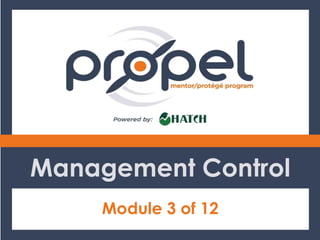Signaler
Partager
Télécharger pour lire hors ligne

Recommandé
Recommandé
Contenu connexe
Tendances
Tendances (20)
Sharpening Your Sales Skills to Maximise Impact - Using Daily OKRs

Sharpening Your Sales Skills to Maximise Impact - Using Daily OKRs
Fashion Merchandising 6.04 Steps of a Fashion Promotion Plan

Fashion Merchandising 6.04 Steps of a Fashion Promotion Plan
Updated: 30 60 90 Day Sales Action Plan Updated Version

Updated: 30 60 90 Day Sales Action Plan Updated Version
En vedette
En vedette (17)
Event Marketing -- Executive Events -- Hatch 1000 Four Workshop

Event Marketing -- Executive Events -- Hatch 1000 Four Workshop
Crafty’s + Drink Tank at Startup Night at Hatch in Norfolk, VA

Crafty’s + Drink Tank at Startup Night at Hatch in Norfolk, VA
What can you build with the tools in your pocket; Carry Norfolk style! 

What can you build with the tools in your pocket; Carry Norfolk style!
Similaire à Propelmancon
Similaire à Propelmancon (20)
Managers skills ,Coaching ,Performance review meetings

Managers skills ,Coaching ,Performance review meetings
Strategic planning & management by objectives (mbo)

Strategic planning & management by objectives (mbo)
Plus de Hatch
Plus de Hatch (20)
Growing Your Business Through Recycling Your Existing Work

Growing Your Business Through Recycling Your Existing Work
8 Proven Ways To Recycle Your Content To Boost Exposure

8 Proven Ways To Recycle Your Content To Boost Exposure
8 Knock-Em Out Of The Park Strategies To Leverage The Work You've Already Don...

8 Knock-Em Out Of The Park Strategies To Leverage The Work You've Already Don...
Propelmancon
- 2. Management Control • Why Management – If not you, who? • What is Management? • What Needs to be Done? • Who Will do It? • Framework for Management Decision Making
- 3. Balancing Control & Flexibility Limited Resources Money Time People
- 4. 4 Key Management Activities Planning Controlling Organizing Directing
- 5. 4 Key Management Activities • Planning – Setting goals, developing work maps, showing how these goals can be accomplished • Organizing – Bringing together resources, determining effective ways of accomplishing goals, integrating resources • Directing – Ensuring that work functions are performed, identifying who will do given tasks and motivating people to do them • Controlling – Feedback of results, follow-ups, making adjustments where needed
- 6. Top Management Work • Technical Skill – Ability to use knowledge, methods, techniques, and equipment necessary for the performance of tasks • Human Skill – Ability and judgment in working with and through people including and understanding of motivation and effective leadership • Conceptual Skill – Ability to understand the complexities of the overall organization and how the various parts fit together, interact and contribute to or inhibit the organizations effective operation
- 7. Who Will Do The Work? • Problems: – One-man-band syndrome • One person ends up doing everything • Ineffective way to run a business – Fire Fighting • All attention is devoted to the biggest problem at the time • May fail to allocate time to the performance of other important functions
- 8. Motivating Employees • Theory X – Tell employees what to do – Punish for work not done • Theory Y – Involve employees in designing their work – Reward for work accomplished
- 9. Management By Exception MBE: • Routine decisions and actions are handled through policy guidelines • Only exceptions, deviations, or emergencies are routed up through the management hierarchy
- 10. Management Control Four-Step Approach: 1. Identify goals 2. Develop work plans 3. Anticipate problems 4. Establish performance evaluation criteria
- 11. Step #1: Identify Goals Examples: • I want to achieve $_______ in sales over the next five years. • I want to develop _______ new products during the next operating period. • I want to add _______ new customers over the next 18 months. • I want to penetrate the _______ market.
- 12. Step #2: Develop Work Plans • Select the best route for arriving at your goal – What are you going to do? – What must you do to get there? – What specifically needs to happen before the goals can be accomplished? • Specific Plan – Ex. Add a new salesperson • Recruit à Select à Hire à Orient à Train à Adds to your objective
- 13. Step #3: Anticipate Problems • Proactive vs. Reactive – Anticipating problems gives you the opportunity to prepare • Contingency Planning – Decide what will be done if it does not work out – Also plan what will be done if the business grows too fast
- 14. 3 Problems With Business Success 1. Compression of Time 2. Compression of People 3. Compression of Money
- 15. Step #4: Establish Evaluation Criteria • Communication between management and employees • Follow up on what has been done • Review what still needs to be done
- 16. Organizational Mapping • Functional/Task approach – Map out tasks – Assign time to tasks – Map out staff – Assign tasks to staff – Compare total task time to total staff time
- 17. Q&A
